Bones reveal gruesome death of Roman man who may have died by lion in York arena
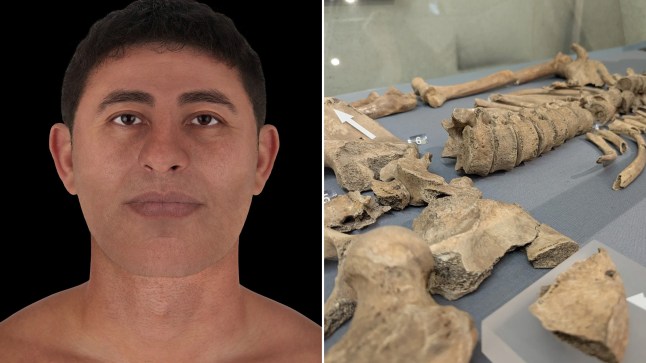

A Roman thought to be a gladiator stares out in a visual reconstruction of a man who met a gruesome end almost 2,000 years ago.
The lifelike image by forensic artist Hew Morrison used the skull of a ‘bold and strong-looking’ individual whose savaged remains were found in York.
New research has found that the man was attacked by a large cat, most likely a lion, and suffered bites to his pelvis around the time he died.
Known only as 6DT19, he was a well-built male aged between 26 and 35 who was likely to have died in one of Rome’s brutal arenas.
His remains were among 83 decapitated skeletons found by York Archaeology between 2004 and 2005 at a burial site dating back around 1,800 years in Driffield Terrace near the city centre.
The Roman skeleton is thought to be the only one of its kind in the world found with evidence of large cat bites.
Despite the combat being imagined in films like Gladiator, forensic evidence has been thin on the ground.
Working alongside educational charity York Archaeology, Morrison, who is based in Thailand, used pictures of the man’s skull and studied an osteology report about the make-up of the bones, which revealed southern European DNA. He then digitally rebuilt the face and upper body using computer software.
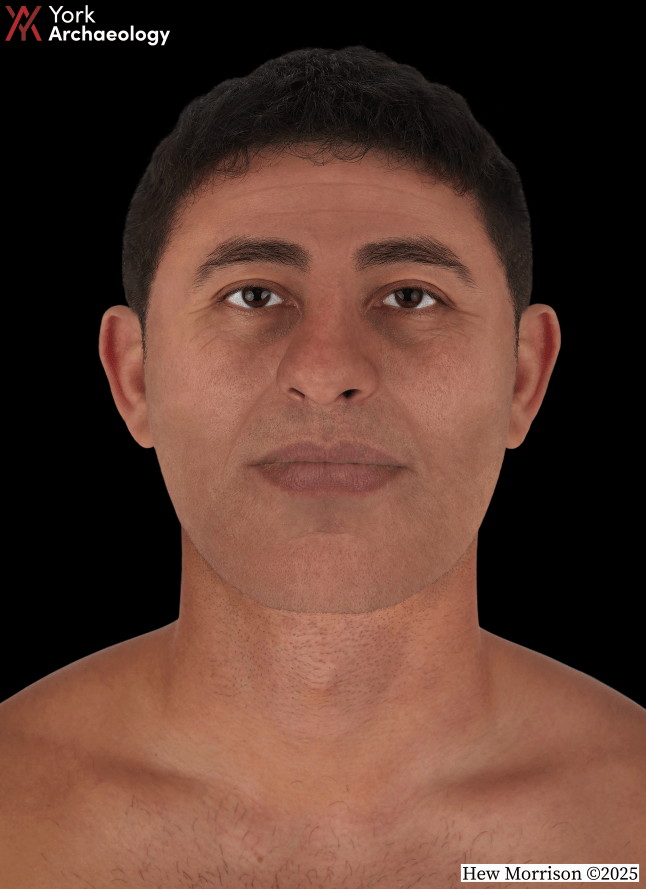
He told Metro: ‘Due to the nature of this archaeological and historical find, I found this to be a fascinating and significantly unique assignment.
‘From initially seeing the skull to when the reconstruction was completed, it became clear that this was the face of a very bold and strong-looking man who would most likely have stood out in a crowd.’
Gladiators fighting ferocious big cats have been immortalised in art and film, and the possibility that this type of combat caused the man’s death is one of the most intriguing aspects of the find.
‘Many of the skeletons showed signs of healed injuries and hard physical work that pointed to them having taken part in combat and having wielded weapons during their lives,’ Morrison said.
‘One-on-one human battles in Colosseum-type settings were a form of public entertainment in ancient Roman society.
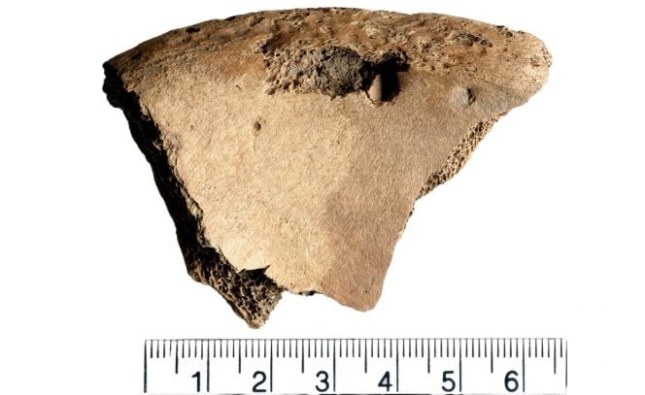
‘However, what makes individual 6DT19 different from the other skeletons found at the site is quite remarkable — and a world first.
‘His skeleton revealed signs of trauma that were caused by human to animal combat. The injuries on his pelvic region were caused by a large carnivore type animal, such as a lion.
‘Throughout time there have been suggestions of humans having been put into a public arena to battle large animals — as seen in mosaics, stone carvings, pottery and ancient texts, but until now there had not been any cogent evidence of such activity.’
The pop stars of the day
Gladiators were originally prisoners or slaves from places Rome was fighting wars with. After the Roman republic ended and the emperors took over, they became professionals who could have a good standard of living and, if they lived long enough, fame.
Fighting at amphitheatres including sword-fighting and pitted humans against animals, including bears and lions.
While they remained lowly, many of the fighters were incredibly popular and they have been likened to today’s pop stars.
Malin Holst, of the University of York’s Department of Archaeology, said: ‘We often have a mental image of these combats occurring at the grand surroundings of the Colosseum in Rome, but these latest findings show that these sporting events had a far reach, well beyond the centre of core Roman territories.
‘An amphitheatre probably existed in Roman York, but this has not yet been discovered.’
The burial site has been dated to between the 1st and 4th century AD and is thought to be the world’s only well-preserved Roman gladiator cemetery.
All but one of the skeletons, which were buried over a 200-year period, are young adult males, with 39 decapitated, the majority from behind.
They are all of a similar height, matching the minimum requirement for the Roman army, and originated from other parts of the empire, including the Middle East, mainland Europe and the Mediterranean.
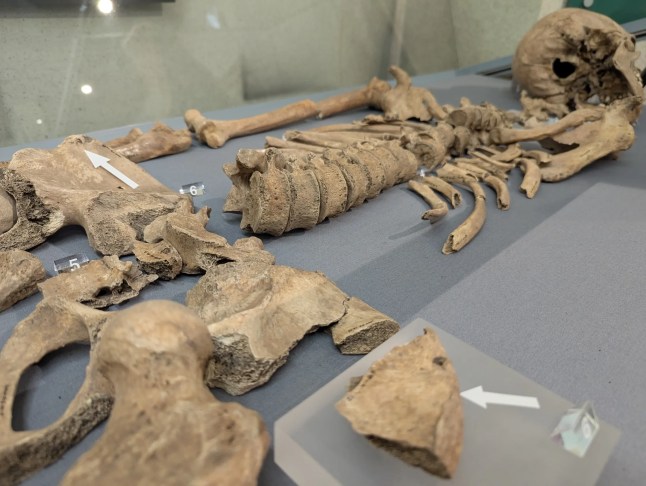
Only a few bodies were buried each year, suggesting that if gladiatorial combat was taking place in Roman York, it did so over many generations.
Christine McDonnell, head of collections for York Archaeology, said: ‘Looking at the skeletons as a group helps us to interpret who they are and why they were buried there – and a number of factors support one idea that these were gladiators, including the way the young men’s bodies had developed and the healed wounds you can see on their skeletons, from training or from combat.’

New research led by Professor Tim Thompson from Maynooth University in Ireland matched marks on the man’s pelvis with sample bites from large carnivores at a zoo, confirming that he was bitten several times by a lion.
Because the wound had not healed it indicates that it occurred around the time of his death, rather than as a result of scavenging, although he was also decapitated, in common with the other skeletons.
Mystery surrounds many parts of the story — including the location of the arena where gladiatorial combat would have taken place.
Another unanswered question is how a lion would have ended up in York.
Ultimately, 6DT19 could have met his end in an encounter with a trophy animal shipped to the city by a wealthy Roman.
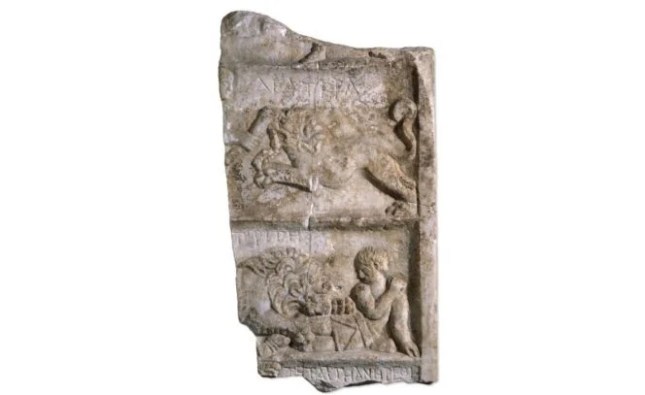
David Jennings, chief executive of York Archaeology, said: ‘What we do know is that bringing a lion to York would have been very expensive.
‘Likely captured in North Africa, purchasing the animal would have cost up to 150,000 sestertii, the equivalent of four years’ wages for a labourer.
‘A lion was the ultimate gladiatorial spectacle – the most expensive animal you could buy – so clearly there were some incredibly wealthy individuals in York sponsoring these bouts, which took place over a long period.’
The skeleton is a centrepiece in the Life in Death in Roman Eboracum exhibition at DIG: An Archaeological Adventure in York’s St Saviourgate, displayed alongside Morrison’s reconstruction.